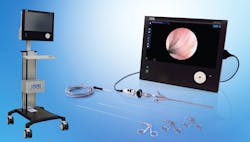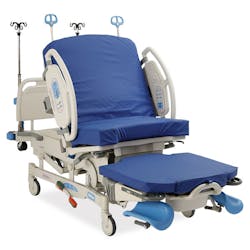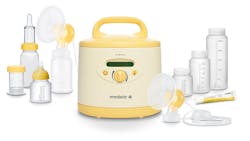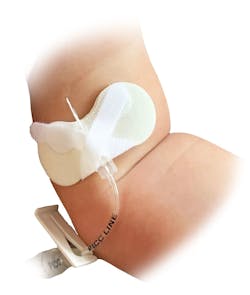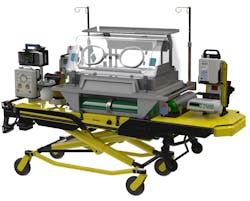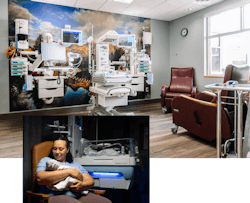Woman’s health spans a broad spectrum of life stages, diseases, and conditions, including pregnancy and post-partum care. While one article can’t possibly cover the full scope of women’s health, let’s look at some of the innovations helping providers care for women throughout their lifetimes, and in the case of mothers, their babies as well.
Women’s health and unique challenges to care
Female patients face unique health conditions not experienced by their male counterparts, including menstrual cycles, pregnancy, menopause, reproductive cancers, and a higher risk for breast cancer. And for conditions that impact both men and women, the symptoms may present differently.
For example, a study published in May 2022 on JAMA Network Open analyzed data on 2,264 heart attack patients 55 and younger, looking at risk factors for men and women. While leading heart attack risk factors for men were current smoking and family history of heart attack, diabetes was further up on the list for women. Depression, high blood pressure, and low household income were stronger risk factors for women than family history.1
“Because women can present differently with symptoms, be an empathetic and good listener. When women talk about depression or when they are having chest pains their concerns can be minimized when the clinician dismisses them as being over emotional. That presents a problem with women wanting to step forward and talk about their symptoms. Clinicians acknowledging the symptoms are real and taking them seriously is really important.”
Dr. Baldwin notes how women who are caring for children, elderly parents or other family members tend to put themselves last when it comes to healthcare.
“It’s often not in the forefront of women’s minds to seek healthcare for themselves so they definitely have more delays in care, which can lead to higher costs and higher morbidity and mortality,” said Dr. Baldwin. “Access to care that is easy and on their time is important.”
Dr. Baldwin said is it also about providing women easier access to birth control and safe reproductive care. And as screening recommendations change for conditions, such as breast and colon cancer, women have more questions about when they should be screened based on risk factors. She states:
“As our prevention and screening recommendations change as we learn, how can technology and telehealth really help get people the right care that they need so they don’t waste a visit? Let’s say you are 39 years old, you just had a pap last year and have no risk factors for cervical cancer but you need a birth control refill. You don’t need to go into a physician’s office for that. Maybe you have anxiety and depression – spend time talking with your physician about that. It is about creating a meaningful healthcare experience for women.”
A cutting-edge approach to HPV testing
When detected as pre-cancer, cervical cancer is avoidable. According to the Centers for Disease Control and Prevention (CDC), every year in the United States 11,000 women are diagnosed with cervical cancer caused by human papillomavirus (HPV), and more than 4,000 women die from cervical cancer. 2 Today, clinicians can stop this alarming rate of deaths by testing women for HPV before it causes cancer.
The BD Onclarity HPV Assay is the only U.S. Food and Drug Administration (FDA) approved HPV test that individually identifies HPV 31, which poses a higher risk for cervical precancer as compared to HPV 18. The BD Onclarity HPV Assay with extended genotyping allows for a more precise, accurate way to measure a woman’s risk for developing cervical precancer compared to an assay with partial genotyping. 3, 4, 5More accurate breast cancer diagnosis
Early detection of breast cancer improves survival rates,6 but approximately 20-30% of women with breast cancer have tumors that are missed by mammogram screening.7 The use of digital breast tomosynthesis (DBT), also known as 3D mammography, allows radiologists to look through tissue layers, “making it less likely they’ll miss an early sign of cancer.”8
Koning’s Breast CT (KBCT) is a revolutionary 3D breast imaging device that produces real 3D images of the breast. KBCT provides exceptional spatial resolution, dramatically improving the way clinicians visualize and evaluate breast tissue while improving the patient exam experience.
Enabling a more convenient setting for hysteroscopy
Up to one-third of women will experience abnormal uterine bleeding in their lifetimes,9 which can be a sign of fibroids, polyps, endometriosis, adenomyosis, hyperplasia, infection, or cancer.10
Uterine cancer (also known as endometrial cancer) is the most common gynecologic cancer in the U.S.11 and it is on the rise, particularly among Black women. Recent research revealed the death rate from uterine cancer among Black women was twice that of other racial and ethnic groups.12 A new study points to a potential cause: hair straightening products. A study from the National Institutes of Health found women who use these products are twice as likely to develop uterine cancer than those who do not.13
Hysteroscopy is commonly used in the diagnosis of uterine cancer, as well as other conditions of the uterus, and KARL STORZ has developed technology and tools to facilitate this endoscopic technique outside of the hospital setting.
“Recent advances in endoscopic technology are enabling a growing number of doctors to perform hysteroscopies in their offices rather than hospital-based settings,” said Anna Palian, Group Marketing Manager, Gynecology & Fetoscopy, KARL STORZ. “Moving hysteroscopy procedures out of the OR allows for increased physician productivity and increased patient satisfaction while supporting population health in a cost-effective way.”
KARL STORZ offers an extensive office hysteroscopy portfolio, with products designed to perform the full range of endoscopic intrauterine procedures. A key enabling technology is the TELE PACK+, a compact self-contained unit that combines all the components needed for hysteroscopy—camera, light source, display, documentation, and network connectivity.
Beyond state-of-the-art products, KARL STORZ offers extensive value-added tools to facilitate seamless introduction of hysteroscopy procedures to the office setting. These tools provide efficient management of assets, education of the staff, and financial solutions to eliminate capital outlays.
“At KARL STORZ, we are dedicated to the advancement of women’s health across the continuum of care,” Palian added.
Technologies now shaping pregnancy, birth, neonatal care
Hospitals have made major strides in maternal/fetal care over the decades to improve outcomes, reduce the risk for complications, and improve patient comfort and satisfaction. Research has shown how “ensuring maternal satisfaction of childbirth services is essential for preventing anxiety, promoting treatment adherence, preventing disease and health promotion.”14
In the neonatal intensive care unit (NICU), family involvement in their baby’s care can improve both short- and long-term outcomes, help facilitate successful breastfeeding, and promote healthy growth and neurodevelopment.15
Here are some ways technology is supporting higher satisfaction, improved quality, and healthier patients from prenatal through postnatal care.
Monitoring fetal development
Ultrasound is a critical tool for monitoring the health of mom and baby during pregnancy, but there are multiple limitations on data sharing of images between providers and their patients, says Matthijs Groot Wassink, General Manager, Point of Care Ultrasound at Philips. When an ultrasound is performed by one provider in a healthcare facility, it is challenging for them to share it with providers at other facilities for collaborative decision making.
If a provider wants to share ultrasound images with their patient, they can use costly thermal printing or download the information onto a USB drive or DVD, both of which present the risk that the images or data will be misplaced. For patients who want real-time data on their pregnancies, especially those at high-risk for complications, neither of these options meet that need.
Groot Wassink describes how the Philips FetView cloud-based fetal ultrasound image sharing and reporting platform allows for easier and more efficient data sharing:
Freedom of movement during labor
Studies have shown how maternal position during labor and delivery can influence duration of labor. Upright positioning helps the uterus contract more strongly and efficiently, positioning the baby to pass through the pelvis faster.16 But conventional fetal monitors can restrict the mother’s mobility and movement.
To facilitate greater mobility and comfort during labor, while at the same time perform essential monitoring, Philips has developed the Avalon beltless fetal monitoring solution. Instead of conventional ultrasound technology, the beltless solution uses ECG and EMG signals to extract fetal and maternal heart rates and uterine activity from the mother’s abdomen.
The solution consists of the reusable CL Fetal & Maternal Pod, and the single-use CL Fetal & Maternal Patch. The caregiver attaches the adhesive electrodes of the patch to mother’s abdomen, then magnetically connect the pod to the patch. The pod communicates with the Avalon CL base station, and the comfortable patch replaces the sweat soaked and pinching belt, removing the need for readjustment as the delivery progresses. The caregiver can concentrate on caring for the mother and rely on the technology to provide them with continuous monitoring, even under challenging conditions.
“New technologies, such as beltless and remote fetal monitoring, mobile low-cost hand-held ultrasounds, and apps that provide access to patients on-the-go fetal, maternal heart rate and contraction monitoring are game-changers for at-risk pregnancies,” says Sachin Chaudhari, General Manager, Clinical Applications and Devices at Philips. “By meeting moms where they are, clinicians and payers can reduce this tension, improve outcomes, and even lower costs by increasing their ability to predict and proactively treat at-risk patients.”
Safe and comfortable delivery
Supporting healthy nutrition from the start
“Breastfeeding is associated with improved infant health and immune development, less incidences of gastrointestinal disease and lower mortality rates than formula fed infants.”17
But a study of newly postpartum moms found perceived insufficient milk as the primary reason for breastfeeding discontinuation globally.18 Medela’s Symphony PLUS, the number one breast pump used in hospitals,19 is clinically proven to support the initiation and maintenance of breast milk supply, significantly increase breast milk production and reduce pumping time through faster let-down and milk flow.20
“The reseach-based Initiation Technology featured in Symphony PLUS was developed specifically to support mothers of preterm and term infants to initiate, build and maintain an adequate milk supply by combining stimulation phases, an expression phase and a pause phase that mimic healthy infant feeding behaviors,” said Patrice Hatcher, MBA, BSN, RNC-NIC, Clinical NICU Specialist, Medela.
Symphony PLUS is available in most U.S. hospitals to help new moms initiate lactation, and it is available for rent through Medela, allowing moms to continue using Symphony PLUS at home to build and maintain their supply.
Securing for safety
Many babies in the NICU require placement of a peripherally inserted central catheter (PICC) to facilitate the delivery of nutrition and medications, but PICC line dislodgement is a common occurrence among patients of all ages. In one survey of clinicians, 96% identified peripheral intravenous catheters as most common device experiencing accidental dislodgement.24
Transformation in neonatal transport
With nearly 70,000 neonatal transports to tertiary centers occurring in the U.S. each year,25 transport is an area of critical importance to healthcare organizations and their NICU patients.
It all started back in the 1970s when U.S. states “developed coordinated regional systems for perinatal care that were predominantly focused on neonatal outcomes,” with designated regional or tertiary care centers providing the highest levels of care. “Numerous studies validated the concept that improved neonatal outcomes were achieved through the application of risk-appropriate maternal transport systems.”26
In the early days of transport, “infants were transported from the referring hospitals in a variety of conveyances with personnel who had no special training in the care or transport of premature or ill newborns,” sometimes by parents in their own vehicles. But over the past 50 years, transport has evolved with the “development of sophisticated equipment to treat and transport infants…in concert with the development of specific clinical skills for transport personnel.”27
“Compared with other populations, newborn transports require more interventions, involve more complications and as such require specialized teams to improve outcomes. The goal of neonatal transport is to stabilize the patient in an efficient manner, as extended time in the field is associated with increased mortality. The goal is not to bring the NICU to the baby but rather to bring the baby to the NICU.”
Technimount EMS recently introduced its Neonatal Stretcher System designed to comply with the highest industry safety standards for the transport of medical equipment during neonatal inter-hospital transfers in critical care settings. Through the optimization of patient transport, this scalable solution ensures the centralization of the necessary equipment on the stretcher and provides security and flexibility.
“Our Neonatal Stretcher System is the most reliable solution on the market, becoming a valuable addition to the critical care team to provide optimal care to patients in their first stage of life,” said Nancy Morest, Director of Business Development at Technimount. “Previously impossible, transport teams are now able to use the medical devices available and adapt the solution according to their unique and evolving needs. This system provides continuous access to medical device monitors and controls, thereby increasing safety and making patient care more efficient and responsive.”
The tale of two NICUs: Evidenced-based design and equipment
While every parent envisions a perfect, full-term delivery of a healthy baby, preterm birth affects 1 in every 10 infants born in the U.S. with many of them requiring care in the neonatal intensive care unit (NICU).21
Preterm NICU patients often require specialized care, such as temperature control, respiratory care, and noise and light protection.22 Family centered care, where parents are encouraged to be part of their baby’s care team, has been shown to improve infant weight gain, decrease stress and anxiety in parents, and increase high-frequency exclusive breastmilk feeding rates. Additionally, skin-to-skin care improves breastfeeding duration, milk production, parental satisfaction, and bonding.23
Based on the need and the evidence, hospitals across the U.S. have been renovating their NICUs or building completely new units to help premature babies survive and thrive.
Mountain View Hospital
Mountain View Hospital (MVH), a physician-owned hospital located in Idaho Falls, Idaho, recently opened a new Level III NICU where its team of highly trained neonatologists, registered nurses, respiratory therapists, pharmacists, lactation specialists, occupational therapists and social workers work closely with parents to provide the best outcomes for their babies.
“Thousands of little boys and girls have been born at Mountain View Hospital over the past 20 years,” said MVH NICU Manager Brandi Klingler. “A vast majority of children enter the world without complications. However, some babies need some extra help. Our team decided to open a state-of-the-art NICU in 2021. We wanted to provide our community with another option for babies born as early as 25 weeks and moms experiencing high-risk pregnancies. Today, we are proud to deliver the most babies in the region and be a facility where all babies are welcome.”
The MVU NICU was intentionally designed to keep families together to improve health outcomes for babies. Infants are housed in individual suites with comfortable spaces for parents to relax and access to important items they may need, such as breast pumps and milk warmers. Parents have around the clock access to the NICU and can even stay overnight if they do not want to be away from their little one.
MVU built its NICU using the latest technology available. The isolettes, warmers, monitors and ventilators created by Dräger, take baby’s every need into account. The equipment is designed to regulate temperature for optimal health, provide the perfect amount of lighting to avoid overstimulation, and reduce noise to protect baby’s highly sensitive ears. Every detail has been carefully considered to make sure babies get the best start possible.
University Health Kansas City Truman Medical Center
Nearly half of all babies born in Kansas City, Mo., enter the world at University Health Kansas City Truman Medical Center (TMC) but its existing Level III NICU, built in 1979, needed updating.
The NICU team sought to renovate its space to better reflect the high level of care that TMC and its clinicians and staff provide, and the hospital secured the required funding. They teamed up with Dräger for innovative design services and advanced neonatal technologies to create a Level III NICU that simultaneously meets the needs of babies, families and staff.
The TMC NICU team wanted their new space to support closeness between baby and caregiver. They also wanted it to be a neuroprotective environment where premature infants were shielded from bright lights and loud noises their developing brains and bodies are not ready to process.
The decision was made to transition from housing all 22 NICU babies together in one triage room, to each baby having their own individual room where they could be together with their family. To equip the new NICU rooms, they chose the Dräger Babyleo TN500 IncuWarmer, BiliLux LED Phototherapy Light, GeminaDUO Wall-mount System, Infinity Acute Care System, and Babylog VN500 ventilators.
During the design process, the TMC NICU team visited the Dräger Healthcare Design Center in Telford, Pa. to visualize the entire workspace, and physically navigate the placement of devices, which helped them build proper traffic and workflows.
“We were working in a very dated space but the care we provided was unbelievable,” said TMC Director of NICU Connie Potts, RNC-NIC. “So, to be able to take amazing technology and put that with the care, these babies will have even better outcomes.”
“So, what’s really great about the new facility is finally our environment matches what we are able to do with the people that we have,” said TMC’s Chief, Department of Pediatrics, Joshua E. Petrikin, MD, FAAP.
Commenting on the integration between design and equipment and its impact on staff members, TMC Clinical Team Manager Alison McIntyre, MSN, RNC-NIC states: “It is nice to have everything integrated into one because now they only have to deal with one brand.”
“I am so glad leadership of this hospital made it happen,” said Sandra P. Ganon, RNC-NIC. “Also to all the contributors who made this unit possible.”
References
1. Women’s heart attacks more strongly connected to different risk factors than men’s, Harvard Health Publishing, October 1, 2022, https://www.health.harvard.edu/womens-health/womens-heart-attacks-more-strongly-connected-to-different-risk-factors-than-mens
2. Cancers Caused by HPV, CDC, https://www.cdc.gov/hpv/parents/cancer.html
3. Monsonego J et al. Gynecol Oncol. 2015;137(1):47-54
4. Stoler MH et al. Am J Clin Pathol. 2019;151(4):433-42
5. Salazar K et al. J Am Soc Cytopath. 2019;8:284-92
6. Ginsburg O, Yip CH, Brooks A, Cabanes A, Caleffi M, Dunstan Yataco JA, Gyawali B, McCormack V, McLaughlin de Anderson M, Mehrotra R, Mohar A, Murillo R, Pace LE, Paskett ED, Romanoff A, Rositch AF, Scheel JR, Schneidman M, Unger-Saldaña K, Vanderpuye V, Wu TY, Yuma S, Dvaladze A, Duggan C, Anderson BO. Breast cancer early detection: A phased approach to implementation. Cancer. 2020 May 15;126 Suppl 10(Suppl 10):2379-2393. doi: 10.1002/cncr.32887. PMID: 32348566; PMCID: PMC7237065.
7. Understanding the aggressive breast cancers missed by mammogram screening, OHSU, June 30, 2020, https://news.ohsu.edu/2020/06/30/understanding-the-aggressive-breast-cancers-missed-by-mammogram-screening
8. Digital Breast Tomosynthesis (3D Mammography), Yale Medicine, https://www.yalemedicine.org/conditions/digital-breast-tomosynthesis
9. Davis E, Sparzak PB. Abnormal Uterine Bleeding. 2022 Sep 9. In: StatPearls [Internet]. Treasure Island (FL): StatPearls Publishing; 2022 Jan–. PMID: 30422508.
10. Uterine Diseases, Medline Plus, https://medlineplus.gov/uterinediseases.html
11. Uterine Cancer Statistics, CDC, https://www.cdc.gov/cancer/uterine/statistics/index.htm
12. Study Uncovers Clues to Rise in Uterine Cancer Death Rates, Associated Press, May 5, 2022, https://www.usnews.com/news/health-news/articles/2022-05-05/study-uncovers-clues-to-rise-in-uterine-cancer-death-rates
13. Frequent hair straightener use doubles uterine cancer risk, Medical News Today, October 20, 2022, https://www.medicalnewstoday.com/articles/frequent-hair-straightener-use-doubles-uterine-cancer-risk
14. adele, M., Bikila, D., Fite, R.O. et al. Maternal satisfaction towards childbirth Service in Public Health Facilities at Adama town, Ethiopia. Reprod Health 17, 60 (2020). https://doi.org/10.1186/s12978-020-00911-
15. Wang Y, Zhao T, Zhang Y, Li S, Cong X. Positive Effects of Kangaroo Mother Care on Long-Term Breastfeeding Rates, Growth, and Neurodevelopment in Preterm Infants. Breastfeed Med. 2021 Apr;16(4):282-291. doi: 10.1089/bfm.2020.0358. Epub 2021 Feb 2. PMID: 33533688.
16. Berta M, Lindgren H, Christensson K, Mekonnen S, Adefris M. Effect of maternal birth positions on duration of second stage of labor: systematic review and meta-analysis. BMC Pregnancy Childbirth. 2019 Dec 4;19(1):466. doi: 10.1186/s12884-019-2620-0. PMID: 31801479; PMCID: PMC6894325.
17. Lyons KE, Ryan CA, Dempsey EM, Ross RP, Stanton C. Breast Milk, a Source of Beneficial Microbes and Associated Benefits for Infant Health. Nutrients. 2020 Apr 9;12(4):1039. doi: 10.3390/nu12041039. PMID: 32283875; PMCID: PMC7231147.
18. Wood NK, Sanders EA. Mothers With Perceived Insufficient Milk: Preliminary Evidence of Home Interventions to Boost Mother-Infant Interactions. West J Nurs Res. 2018 Aug;40(8):1184-1202. doi: 10.1177/0193945916687552. Epub 2017 Jan 17. PMID: 28322655.
19. IQVIA ProVoice Survey; Nov-Oct 2018
20. Mothers using the INITIATE program followed by the MAINTAIN program achieved significantly higher daily milk volumes in the second week after birth, source: Medela.
21. Reproductive Health, Preterm Birth, CDC, https://www.cdc.gov/reproductivehealth/maternalinfanthealth/pretermbirth.htm
22. How NICUs Are Tailoring Their Approach to Care for the Tiniest Babies, Neonatal Intensive Care, Winter 2022, https://nicmag.ca/pdf/NIC-35-1-Winter-2022-R19-post.pdf
23. Family-centered care in the NICU, The Lancet, May 2019, https://doi.org/10.1016/S2352-4642(19)30089-6
24. Nancy Moureau; Impact and Safety Associated with Accidental Dislodgement of Vascular Access Devices: A Survey of Professions, Settings, and Devices. Journal of the Association for Vascular Access 1 December 2018; 23 (4): 203–215. doi: https://doi.org/10.1016/j.java.2018.07.002
25. Perry SE. Fifty Years of Progress in Neonatal and Maternal Transport for Specialty Care. J Obstet Gynecol Neonatal Nurs. 2021 Nov;50(6):774-788. doi: 10.1016/j.jogn.2021.04.013. Epub 2021 Jun 22. PMID: 34166650.
26. Levels of Maternal Care, American College of Obstetricians and Gynecologists (ACOG), August 2019, https://www.acog.org/clinical/clinical-guidance/obstetric-care-consensus/articles/2019/08/levels-of-maternal-care
27. Perry SE. Fifty Years of Progress in Neonatal and Maternal Transport for Specialty Care. J Obstet Gynecol Neonatal Nurs. 2021 Nov;50(6):774-788. doi: 10.1016/j.jogn.2021.04.013. Epub 2021 Jun 22. PMID: 34166650.
About the Author
Kara Nadeau
Senior Contributing Editor
Kara Nadeau is Sterile Processing Editor for Healthcare Purchasing News.




